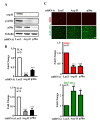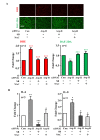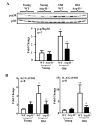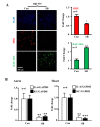Role of p38 mitogen-activated protein kinase in vascular endothelial aging: interaction with Arginase-II and S6K1 signaling pathway
- PMID: 25635535
- PMCID: PMC4350325
- DOI: 10.18632/aging.100722
Role of p38 mitogen-activated protein kinase in vascular endothelial aging: interaction with Arginase-II and S6K1 signaling pathway
Abstract
p38 mitogen-activated protein kinase (p38) regulates cellular senescence and senescence-associated secretory phenotype (SASP), i.e., secretion of cytokines and/or chemokines. Previous work showed that augmented arginase-II (Arg-II) and S6K1 interact with each other to promote endothelial senescence through uncoupling of endothelial nitric oxide synthase (eNOS). Here we demonstrate eNOS-uncoupling, augmented expression/secretion of IL-6 and IL-8, elevation of p38 activation and Arg-II levels in senescent endothelial cells. Silencing Arg-II or p38α in senescent cells recouples eNOS and inhibits IL-6 and IL-8 secretion. Overexpression of Arg-II in young endothelial cells causes eNOS-uncoupling and enhances IL-6 and IL-8 expression/secretion, which is prevented by p38 inhibition or by antioxidant. Moreover, p38 activation and expression of IL-6 and KC (the murine IL-8 homologue) are increased in the heart and/or aortas of wild type (WT) old mice, which is abolished in mice with Arg-II gene deficiency (Arg-II-/-). In addition, inhibition of p38 in the old WT mice recouples eNOS function and reduces IL-6 and KC expression in the aortas and heart. Silencing Arg-II or p38a or S6K1 inhibits each other in senescence endothelial cells. Thus, Arg-II, p38, and S6K1 form a positive circuit which regulates endothelial senescence and cardiovascular aging.
Conflict of interest statement
The authors declare no conflict of interest.
Figures







Similar articles
-
Positive crosstalk between arginase-II and S6K1 in vascular endothelial inflammation and aging.Aging Cell. 2012 Dec;11(6):1005-16. doi: 10.1111/acel.12001. Epub 2012 Sep 18. Aging Cell. 2012. PMID: 22928666
-
p38 mitogen-activated protein kinase is involved in arginase-II-mediated eNOS-uncoupling in obesity.Cardiovasc Diabetol. 2014 Jul 18;13:113. doi: 10.1186/s12933-014-0113-z. Cardiovasc Diabetol. 2014. PMID: 25034973 Free PMC article.
-
Arginase-II induces vascular smooth muscle cell senescence and apoptosis through p66Shc and p53 independently of its l-arginine ureahydrolase activity: implications for atherosclerotic plaque vulnerability.J Am Heart Assoc. 2013 Jul 5;2(4):e000096. doi: 10.1161/JAHA.113.000096. J Am Heart Assoc. 2013. PMID: 23832324 Free PMC article.
-
Functions and regulation of the 70kDa ribosomal S6 kinases.Int J Biochem Cell Biol. 2011 Jan;43(1):47-59. doi: 10.1016/j.biocel.2010.09.018. Epub 2010 Oct 12. Int J Biochem Cell Biol. 2011. PMID: 20932932 Review.
-
Regulation of senescence traits by MAPKs.Geroscience. 2020 Apr;42(2):397-408. doi: 10.1007/s11357-020-00183-3. Epub 2020 Apr 16. Geroscience. 2020. PMID: 32300964 Free PMC article. Review.
Cited by
-
Integrating strategies of metabolomics, network pharmacology, and experiment validation to investigate the processing mechanism of Epimedium fried with suet oil to warm kidney and enhance yang.Front Pharmacol. 2023 Jan 25;14:1113213. doi: 10.3389/fphar.2023.1113213. eCollection 2023. Front Pharmacol. 2023. PMID: 36762111 Free PMC article.
-
Biogenesis of Pro-senescent Microparticles by Endothelial Colony Forming Cells from Premature Neonates is driven by SIRT1-Dependent Epigenetic Regulation of MKK6.Sci Rep. 2017 Aug 15;7(1):8277. doi: 10.1038/s41598-017-08883-1. Sci Rep. 2017. PMID: 28811647 Free PMC article.
-
Arginase: shedding light on the mechanisms and opportunities in cardiovascular diseases.Cell Death Discov. 2022 Oct 8;8(1):413. doi: 10.1038/s41420-022-01200-4. Cell Death Discov. 2022. PMID: 36209203 Free PMC article. Review.
-
Premature senescence of endothelial cells upon chronic exposure to TNFα can be prevented by N-acetyl cysteine and plumericin.Sci Rep. 2017 Jan 3;7:39501. doi: 10.1038/srep39501. Sci Rep. 2017. PMID: 28045034 Free PMC article.
-
Is Senolytic Therapy in Cardiovascular Diseases Ready for Translation to Clinics?Biomolecules. 2025 Apr 8;15(4):545. doi: 10.3390/biom15040545. Biomolecules. 2025. PMID: 40305307 Free PMC article. Review.
References
-
- Kovacic JC, Moreno P, Nabel EG, Hachinski V, Fuster V. Cellular senescence, vascular disease, and aging: part 2 of a 2-part review: clinical vascular disease in the elderly. Circulation. 2011;123:1900–1910. - PubMed
-
- Yepuri G, Velagapudi S, Xiong YY, Rajapakse AG, Montani JP, Ming XF, Yang ZH. Positive crosstalk between arginase-II and S6K1 in vascular endothelial inflammation and aging. Aging Cell. 2012;11:1005–1016. - PubMed
Publication types
MeSH terms
Substances
LinkOut - more resources
Full Text Sources
Other Literature Sources
Molecular Biology Databases
Research Materials

